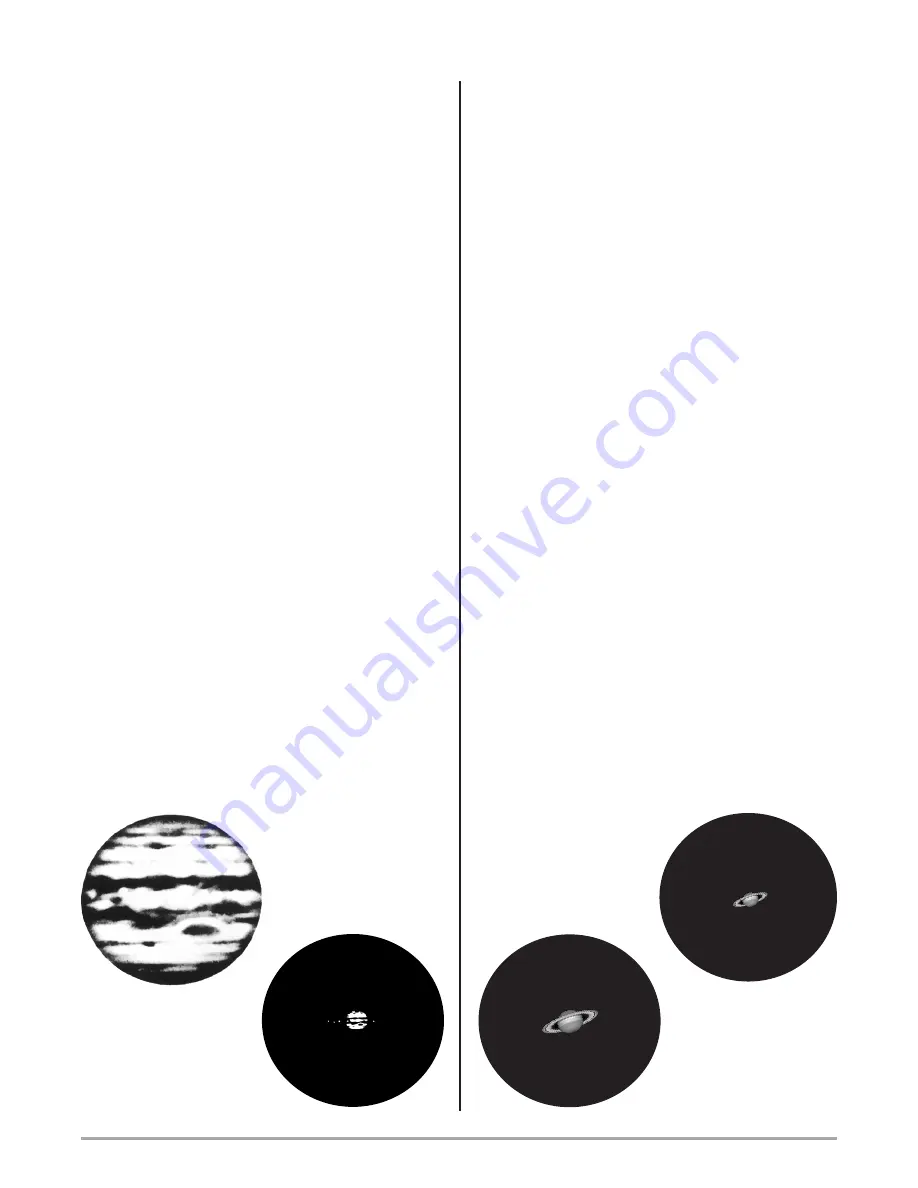
a.hint.of.a.disk,.making.it.a.disappointment.to.planet-
watchers.most.of.the.time..During.those.exciting.months.
when. Mars. is. near. opposition. your.Astroscan. may. be.
pushed.to.its.highest.power.of.139X.(the.8.mm.Plossl.
plus.Barlow).to.look.for.greenish-blue.or.grayish.surface.
details.(and.occasional.clouds.or.dust.storms)..The.56X.
magnification.of.the.8.mm.Plossl.itself.typically.suffices.
to.show.one.of.the.polar.caps,.with.either.the.north.or.
south.pole.usually.having.enough.ice.on.it.to.stand.out.
as.a.distinct.white.area.against.the.ruddy-orange.desert.
regions.of.the.planet.
Jupiter
Largest,.most.active.and.–.for.many.observers.–.most.
exciting. of. all. the. planets. is. Jupiter.. It. won’t. look. very.
big. at. 16X. in. the. Astroscan,. but. you’ll. definitely. be.
able.to.tell.that.it.has.a.disk..You’ll.also.notice.several.
small. bright. “stars”. strung. out. in. a. line. on. either. side.
of.it..These.are.the.four.bright.“Galilean”.satellites,.the.
very. same. ones. that. Galileo. first. discovered. with. his.
tiny.telescope.back.in.1610..Each.night.you.look.you’ll.
see.the.satellites.in.a.different.order.because.they.are.
continually.circling.Jupiter.in.periods.ranging.from.1.7.to.
17.days..Sometimes.there.will.be.two.satellites.visible.on.
each.side,.at.other.times.three.on.one.side.and.one.on.
the.other..There.will.also.be.times.when.you.won’t.see.
all.four.because.one.or.more.will.be.hiding.in.Jupiter’s.
shadow,.or.be.behind.or.in.front.of.the.planet.itself..At.
30X.Jupiter.looks.like.a.bright,.yellowish-white,.slightly.
flattened. ball. and,. if. seeing. conditions. are. good,. you.
may.be.able.to.make.out.its.two.large.dark.equatorial.
cloud.belts,.which.are.definite.at.56X..Perhaps.the.most.
striking. aspect. of. observing. Jupiter. is. watching. the.
eclipse. disappearances. and/or. reappearances. of. the.
bright.satellites.as.they.enter.or.leave.the.planet’s.huge.
shadow.over.a.period.of.just.several.minutes.right.before.
your.eyes!.Another.is.seeing.a.satellite.slowly.approach.
Jupiter. and. then. apparently. merge. with. it. as. it. either.
passes.in.front.of.or.behind.it..Times.of.all.the.various.
satellite.events.are.given.in.
Sky & Telescope
.magazine.
whenever.Jupiter.is.well.placed.for.viewing.in.the.sky.
Saturn
The. magnificent. planet. Saturn. looks. oval. or. spindle-
shaped.in.the.Astroscan.at.16X.upon.first.glimpse..But.
switch. to. 30X. and. you’ll. see. it’s. a. tiny. round. planet.
encircled. by. a. ring. seen. somewhat. edge-on.. Most.
impressive,.perhaps,.is.how.“other-worldly”.and.delicate.
it. looks. –. shining. in. the. eyepiece. like. some. exquisite.
piece.of.cosmic.jewelry!.Higher.magnifications.may.bring.
out.a.dark.narrow.gap.in.its.rings.known.as.Cassini’s.
Division,. or. the. shadow. of. the. rings. on. the. planet. or.
of.the.planet.on.the.rings..It.all.depends.upon.seeing.
conditions,. and. also. at. what. angle. we’re. viewing. the.
rings.which.change.their.tilt.as.Saturn.slowly.orbits.the.
Sun..(Roughly.on.average.about.every.15.years,.they.
disappear.completely.for.a.time.as.we.cross.the.plane.of.
the.amazingly.thin.system.of.ice.rings..Most.recently.this.
occurred.in.2009.and.it.will.happen.next.in.2025.).
Near. Saturn,. you. will. see. its. biggest. satellite. Titan,.
which.Iooks.like.a.small.star.(and.not.as.bright.as.any.of.
Jupiter’s.big.moons).at.30X..Under.good.conditions,.you.
might. also. glimpse. several. other. satellites. appearing.
like.very.faint.stars..If.you.look.for.Titan.regularly,.you.
can.follow.it.as.it.swings.around.Saturn,.taking.16.days.
for.each.revolution..A.series.of.little.sketches.made.each.
night.will.help.you.track.its.motion.
Jupiter and its four bright
moons (low power view).
Saturn, shown at two
different magnifications
Complex cloud patterns
in Jupiter's atmosphere
(high power view).



























